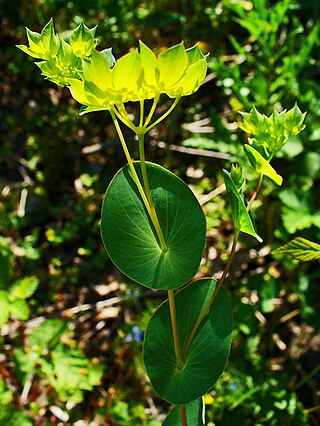
Bupleurum is a large genus of annual or perennial herbs or woody shrubs, with about 190 species, belonging to the family Apiaceae. The full size of its species may vary between a few cm to up to 3 m high. Their compound umbels of small flowers are adorned with bracteoles that are sometimes large and may play a role in attracting pollinators. Rare among the Apiaceae are the simple leaves, bracts, and bracteoles. The genus is almost exclusively native in the Old World Northern Hemisphere, with one species native to North America and one species native to southern Africa.
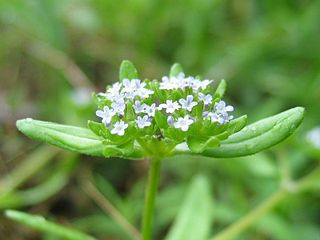
Valerianella is a genus of plant in family Caprifoliaceae. Many plants of this genus are known by the common name corn salad or cornsalad, although that name most often refers to Valerianella locusta.

Crucianella is a genus of flowering plants in the family Rubiaceae. The species are annual herbs found from the Mediterranean to Central Asia and the Arabian Peninsula. One species is naturalized in northern California, southern Oregon, and Idaho.

Muellerolimon salicorniaceum, the sole species in genus Muellerolimon, is a succulent perennial herb or shrub that grows on salt mudflats in Western Australia.

Plocama is a genus of flowering plants in the family Rubiaceae. It was described by William Aiton in 1789. It is distributed from the Canary Islands to northwestern India.

Bukiniczia cabulica is a plant in the plumbago or leadwort family, Plumbaginaceae. It is the sole species in the monotypic genus Bukiniczia. It is a biennial native to Afghanistan and Pakistan. It forms a basal rosette of leathery leaves, growing a stem with pink flowers in its second year.
Mikhail Grigorevich Popov was a Soviet botanist. He is known for developing a theory on the role of hybridization in plant evolution, and studying the flora of the Soviet Union and Eastern Europe. The standard author abbreviation Popov is used to indicate this person as the author when citing a botanical name.
Igor Alexandrovitch Lintchevski was a Russian botanist.
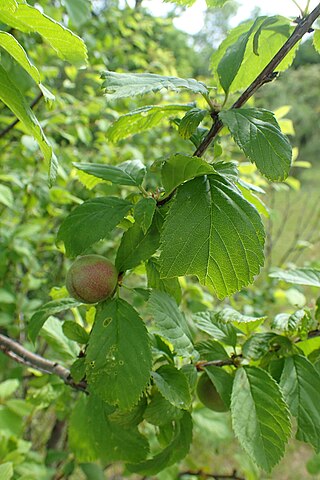
Prunus ulmifolia is species of Prunus native to Central Asia. It is often treated as a synonym of the East Asian species P. triloba. However, they are distinctly different in leaves, flowers and fruits. P. triloba have slightly trilobed leaves, campanulate calyx tubes, unpitted stones, and fruits splitting when ripe, whereas P. ulmifolia have leaves without lobes, cylindrical calyx tubes, stones finely pitted with irregularly branching furrows, and fruits not splitting.
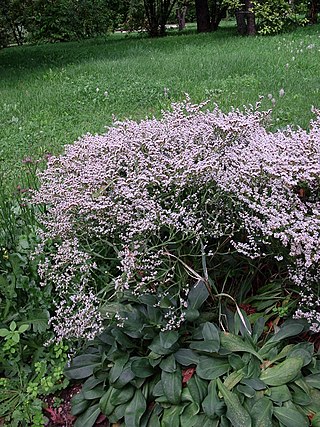
Goniolimon, sometimes called the statices, are a genus of flowering plants in the leadwort and plumbago family Plumbaginaceae, native to northern Africa, southern Europe, western and central Asia, Siberia, Mongolia and China. Low-lying perennial shrubs, some species are cultivated as ground covers.
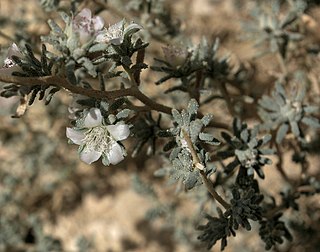
Reaumuria is a genus of flowering plants in the family Tamaricaceae, found in North Africa, Sicily, Anatolia, the Middle East, the Caucasus, Pakistan, Central Asia, Mongolia, Tibet, and northern China. They tend to be perennial xerophytic and halophytic shrubs or subshrubs.

Dianthus crinitus is a species of Dianthus in the carnation family found in northwestern Africa, the eastern Aegean Islands, Anatolia, the Transcaucasus and the North Caucasus, Lebanon, Syria, Iran, the Gulf States, and Oman. Common names may be associated more with some subspecies than others, and include hairy carnation and long‑haired pink. It grows on serpentine soils.
Bamiania is a genus of flowering plant belonging to the family Plumbaginaceae.

Cephalorhizum is a genus of flowering plants belonging to the family Plumbaginaceae.
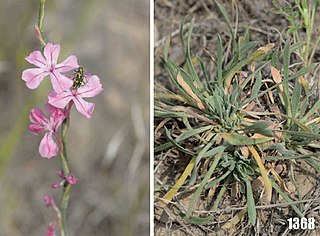
Chaetolimon is a genus of flowering plants belonging to the family Plumbaginaceae.
Neogontscharovia is a genus of flowering plants belonging to the family Plumbaginaceae.
Bakerolimon is a genus of flowering plants belonging to the family Plumbaginaceae, named after Herbert G. Baker, British-American Botanist.
Acantholimon afanassievii is a species of flowering plant in the Plumbaginaceae family. The native range of this species is in Central Asia and it was discovered by Lincz.

Limonium platyphyllum, the broad-leaved statice, or florist's sea lavender, is a species of flowering plant in the family Plumbaginaceae. It is native to the Black Sea region; Bulgaria, Romania, Ukraine, Crimea, south and east European Russia, and the Caucasus, and it has been introduced to Great Britain. A perennial halophyte 60 to 75 cm tall, it is widely available from commercial suppliers. There are a number of cultivars, including the well-known 'Violetta' which has darker petals.












